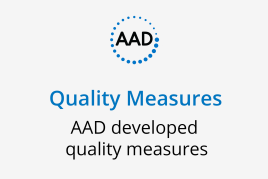How to work with local media
Print and broadcast media, including radio and television, offer the opportunity to reach large audiences with information about the importance of skin cancer prevention, detection and self-examination.
This section will help you use your local media to publicize your screening, Melanoma Monday®, and Skin Cancer Awareness Month. This toolkit includes the following information:
Instructions for developing media lists and using pitch letters, news releases, fact sheets and public service announcements.
Insights from AAD media relations professionals about working with the media and what reporters want to know.
Tips for participating in media interviews.
Sample materials and templates
Preparing to work with the media
It is important to invest some time identifying the right outlets and contacts for your media campaign.
Media lists
Begin by creating a media list, which is comprised of reporters, editors and producers who might be interested in covering a story you want to publicize. You will need a list of contacts at print and broadcast media outlets in your area who might be interested in news or feature stories about skin cancer detection and prevention and your screening program. To develop your media list, you can use your local telephone directory, the Internet or library reference books. The list should include:
Daily newspapers
Weekly community newspapers
Magazines
Television stations including specific news, talk or community affairs programs
Radio stations including specific news, talk or community affairs programs
Call each of the media outlets on your list to obtain the names of the news editor, medical/ health reporter, feature reporter, public service director and any additional contacts who might be interested in stories about skin cancer and your screening.
Additional publications to consider for your media list are the employee or community newsletters published by area businesses, industries, schools and community groups. Call organizations in your area to determine appropriate newsletters and who to contact. Your local Chamber of Commerce may be able to provide additional information.
Contacting the media
Your next step is contacting the media to get them interested in your story. Access templates, fact sheets, and other resources to help you attract the attention of reporters.
Pitch letters and news releases
Pitch letters and news releases are simple and effective tools to generate media interest in a story on skin cancer and your screening program.
A pitch letter can be used to introduce a story or public service announcement about Melanoma Monday, the importance of skin cancer prevention and detection, and screenings.
You can also announce your screening program to the media with a pre-event news release. After the screening, you also can distribute a news release that provides a summary of the results of your program.
Sample pre-event press release (PDF download)
Sample post-event press release (PDF download)
Sample mayoral proclamation (PDF download)
Sample pitch letters (PDF download)
Sample radio PSA scripts (PDF download)
Sample calendar announcement (PDF download)
Sample social media posts (PDF download)
Fact sheets
Fact sheets provide brief background information and statistics on a subject. Fact sheets covering a range of topics relating to skin cancer prevention and detection are available on the AAD website.
Public service announcements
Public service announcements (PSAs) are brief messages of community interest. TV and radio stations donate the air-time for these announcements, and national/local newspapers and magazines print them based on the public service value and quality of the announcements. These announcements are distributed directly to radio, television, and print media outlets nationwide by the Academy’s Communications department.
Some stations prefer announcer-read scripts over pre-recorded messages. Download sample announcer-read 10- and 30-second PSA scripts (document download) for you to complete with information about your screening program.
Working with the media: What reporters want to know
When working with the media to obtain publicity for your screening, you will need to provide them with:
Dates, times and locations of screenings in your community (included in the pre-event news release).
Names and telephone numbers (with permission) of spokespersons available for interviews, including doctors, hospitals and participating facilities.
Accurate facts and figures about skin cancer, melanoma and self-examination.
Information about scheduled events, including mayoral proclamations and community presentations.
Immediately after your screening, there are opportunities to secure additional stories about skin cancer and melanoma by providing:
A news release summarizing the results of your program.
Names and telephone numbers (with permission) of those who participated in the program.
Any important findings, i.e., the number of suspected melanomas or any human interest stories. Please adhere to HIPAA guidelines by getting permission from patients prior to sharing their stories.
The media prefer fresh and timely news, so this information must be provided as soon as possible after the screening.
Tips for a successful interview
Whether you are participating in a live television or radio interview or in an interview with a newspaper reporter, there are several tips to consider to ensure a successful interview.
Before the interview
Confirm the interview time, date and place by letter or telephone.
Provide the interviewer with a short personal biography or
curriculum vitae and offer additional print materials, such as fact sheets and brochures. Include a phone number, if appropriate, for information about your screening program.
Ask if the interviewer wants to talk to any additional medical experts or skin cancer patients.
Do your homework. Prepare for the interview by reviewing and knowing all the updated facts and figures about skin cancer.
Arrive 15 minutes early to familiarize yourself with the setting and then relax.
During the interview
Know the key points you want to get across and state them early during the interview. Repeat the key points at least twice during the interview so the reporter knows you think this information is important. For example, key points you might want to get across in an interview on melanoma are:
Melanoma is the deadliest form of skin cancer and the incidence is on the rise.
If melanoma is detected early, it can be cured. There are medical and surgical treatments available.
When examining your skin, if you notice a change in a mole or a new mole, see your dermatologist right away.
Information, including date and time, on your free screening.
Speak in short, concise sentences.
Relax and speak naturally.
Use lay terms and avoid technical language and medical jargon.
Use examples, stories and anecdotes when possible to dramatize your message.
Anticipate questions that will come up during the interview and be prepared to use those questions as launching pads for your key points.
Some special considerations for television interviews include:
If possible, avoid sitting between two interviewers to prevent the disadvantage of constantly turning to answer questions.
Answer the interviewer directly. Do not talk into the camera unless directed to do so.
Lean slightly forward in your chair. This posture makes you appear interested. Sitting with legs crossed is the most comfortable and natural position for most people.
Check your clothes to make sure they do not appear wrinkled or rumpled when you are sitting. Unbutton your suit jacket when you sit.
Use natural hand gestures.
Offer slides and graphs if appropriate. If available, use horizontal slides rather than vertical ones.
Television lights can make a white shirt or blouse flare. Off-white, beige or pastels are preferred.
Avoid busy patterns, such as herringbones. They tend to “dance” under television lights.
Wear calf-length socks with trousers to prevent skin showing between the sock top and trouser cuff.
Keep jewelry, especially dangling earrings and flashy rings and watches, to a minimum.
 Find a Dermatologist
Find a Dermatologist
 Member directory
Member directory
 2024 AAD Innovation Academy
2024 AAD Innovation Academy
 AAD Learning Center
AAD Learning Center
 Need coding help?
Need coding help?
 Reduce burdens
Reduce burdens
 Clinical guidelines
Clinical guidelines
 Why use AAD measures?
Why use AAD measures?
 Latest news
Latest news
 New insights
New insights
 Physician wellness
Physician wellness
 Joining or selling a practice?
Joining or selling a practice?
 Promote the specialty
Promote the specialty
 Advocacy priorities
Advocacy priorities
